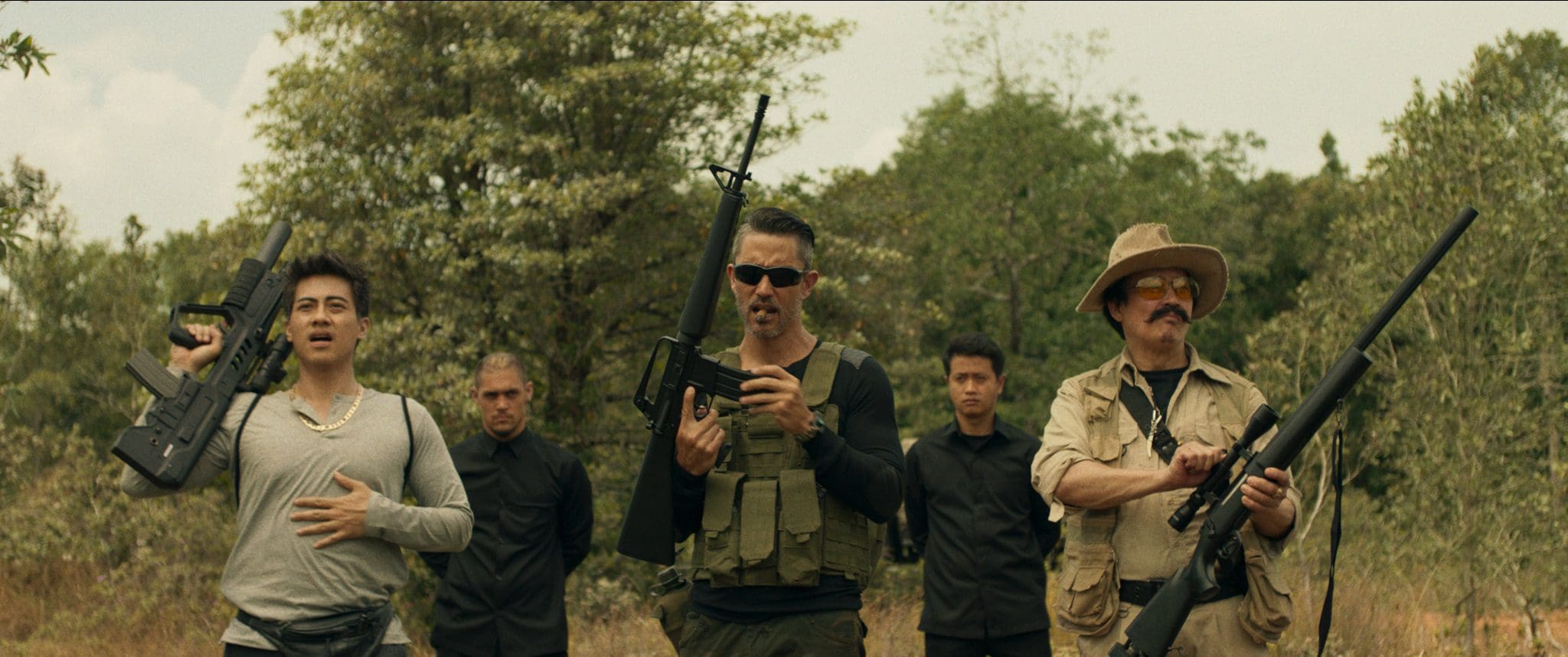
There have been a lot of adaptations of Richard Connell’s short story, “The Most Dangerous Game.” Just this year, Quibi released a serialized version starring Liam Hemsworth. However, nobody watches Quibi, so it’s safe to say many viewers haven’t encountered the story since high school English class. Basically, the titular game is a human being and that unwilling victim is forced to fight for survival when a sadistic hunter decides to kill them for sport. That basic plot provides the framework for writer-director Jimmy Henderson’s new film, The Prey.
Set and filmed in Cambodia, this time, the titular prey is Xin (newcomer Gu Shang Wei), an undercover Interpol agent who is arrested in a building raid and sent to a remote prison run by a sadistic warden (Vithaya Pansringam). When three wealthy men (Byron Bishop, Nophand Boonyai and Sahajak Boonthanakit as Mat, T and Payak, respectively), arrive for the hunt, the warden includes Xin among the prisoners chosen in hopes it will break his steely resolve. Indeed, as events in the jungle spin out of control, the closer Xin comes to losing his humanity.
With many of its story beats a foregone conclusion, arguably the best thing about The Prey is how efficiently it hits those beats. After an impressive opening action sequence filmed largely through long takes, the film quickly gets us to the jungle, and while that efficiency could easily make the film feel rushed, the characters dynamics are juicy enough that we want to get to the action as quickly as possible. Perhaps most responsible for that excitement is Pansringam, who gives by far the most enjoyable performance in the cast. As the warden tortures Xin or pulls faces as he puts on a show for the newly-arrived hunters, Pansringam is a perfect example of sadistic, almost cartoonish evil and the character feels unpredictable in a way that leaves us wondering what he’ll do next.
That said, while Pansringam gets away with playing a caricature purely on the strength of his performance, not every actor is so lucky. The most frustrating among them is Boonyai as T. One of the first things we see the character do is short his buy-in for the hunt just to see if he can get away with it. The moment establishes him as a wildcard and Boonyai plays a fun sociopath as his character follows one anarchic impulse after another. Where he runs into trouble, though, is when the film belatedly and pretty much out of nowhere attempts to make that character more complex.
Late in the film, after an explosion that seems to have killed off our hero, T suddenly has some sort of flashback to a traumatic childhood event that paints even Mat, his uncle, as a villain and he begins to turn on his former allies for the rest of the film. Though that sudden about face could work in theory, Henderson and co-writers Michael Hodgson and Kai Miller don’t give the audience enough context to understand that past trauma. So, T’s sudden turn feels unearned and even though Boonyai commits to the change, he can only do so much with so little character depth to fuel his performance.
Still, like most action movies, The Prey could easily be forgiven for its spotty character work if the fight scenes were thrilling enough, however, the film largely makes the same fatal mistake so many American films do: putting the camera so close to the action that it’s both impossible to read and looks noticeably choreographed. Though the prison riot the hunters use to choose their quarry is almost impossible to follow, the most frustrating example is a fight between Xin and one of the bad guys in the shallows of a river. Finally, Henderson and cinematographer Lucas Gath place the camera far enough away to allow us to see the actors’ fight choreography, but they also place it just above the water line. So, the camera spends much of the scene either half submerged or so distorted by the actors’ splashing that the fight is nearly unreadable.
In that scene and pretty much throughout, Henderson prioritizes the characters’ faces in any given battle and the choice only highlights how scattered the character work is. There is perhaps no example more detrimental than the way the film’s climactic final boss battle ends. It’s difficult to say exactly how without spoiling the whole film (though viewers familiar with Connell’s original short story or really, most action movies, will have a pretty good idea of which characters are involved), but let’s just say our hero has a moment of introspection once the smoke clears and he’s suddenly reminded of something the warden said at the film’s start. The scene is not just a bit of a downer, but a moment of gravitas that feels unearned–and therefore false–in what is otherwise a fun, pulpy action movie.
If anything, The Prey’s final beats reveal that Henderson and his co-writers misunderstand what makes their film work in the first place. By trying to walk the line between serious and silly, Henderson’s film fundamentally fails on both accounts. Instead, The Prey is both an action movie with not enough action and a character drama with too little depth. If only it had been willing to have a little more fun.

